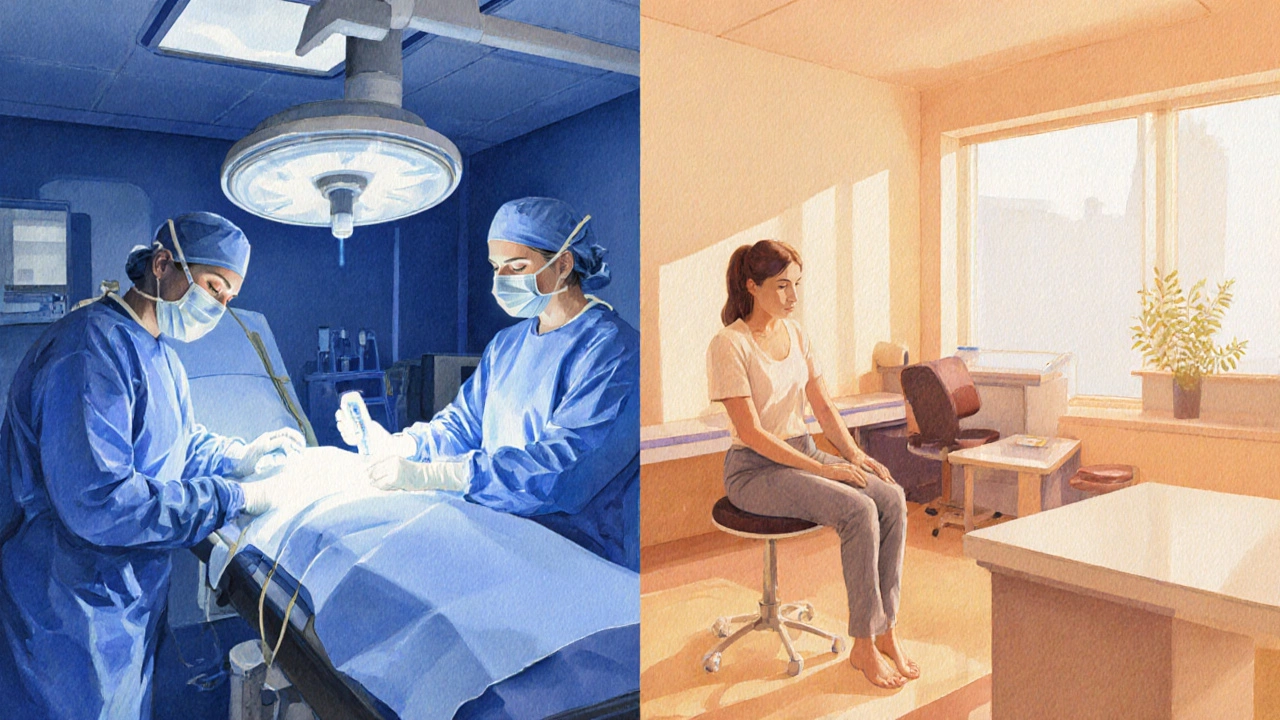Vaginal tightening surgery is a surgical procedure that tightens the vaginal canal and surrounding tissues, typically performed to improve sexual satisfaction, address pelvic floor laxity, or correct functional issues such as urinary incontinence.
What the anatomy tells us
Before weighing any intervention, it helps to know the key structures. The pelvic floor muscle group comprises layers of skeletal muscle that support the bladder, uterus and rectum. The deepest layer, the levator ani muscle, forms a hammock that lifts the pelvic organs and defines the tone of the vaginal walls. When these muscles weaken-often after childbirth, aging, or chronic coughing-the vaginal canal may lose its snugness.
Why women consider tightening
Two common complaints drive the conversation:
- Dyspareunia - pain during intercourse caused by excess laxity or scar tissue.
- Urinary incontinence - leakage that can occur when the pelvic floor cannot close the urethra effectively.
Beyond function, some women seek a tighter feel for aesthetic confidence. Understanding the root cause-muscle weakness versus tissue atrophy-guides whether a surgical or non‑surgical route makes sense.
Surgical pathways
The most established operation is perineoplasty, a technique that trims excess skin and tightens the perineal body, often combined with a vaginoplasty. The surgeon sutures the vaginal walls, shortening the canal by 1-2cm on average.
Key attributes:
- Invasiveness: High - requires general anesthesia.
- Recovery: 4‑6weeks of limited activity.
- Cost (UK, 2024): £3,500‑£6,000 private sector.
- Longevity: Results typically last 5‑10years, though muscle deterioration may recur.
Complications, while uncommon, include infection (2‑5%), scarring, and altered sensation. The NHS guidelines advise that surgery be considered only after conservative therapy fails, emphasizing informed consent and realistic expectations.
Non‑surgical alternatives
For those hesitant about incisions, energy‑based devices have entered the market.
Laser vaginal rejuvenation
This method uses a fractional CO₂ laser to heat the mucosa, prompting collagen remodeling. Typical protocol: three sessions spaced four weeks apart.
- Invasiveness: Low - no cuts.
- Recovery: Minimal; mild soreness for 2‑3 days.
- Cost: £800‑£1,200 per series.
- Longevity: Improvements last 12‑18months.
Radiofrequency (RF) therapy
RF delivers controlled heat to the sub‑epithelial layer, stimulating fibroblast activity. Devices such as ThermaV report a 25‑30% increase in vaginal wall thickness after six months.
- Invasiveness: Low.
- Recovery: No downtime.
- Cost: £600‑£900 per treatment series.
- Longevity: 9‑12months on average.
Collagen stimulation injections
Injectable fillers (e.g., poly‑L‑lactic acid) provide volume and stimulate new collagen. Results appear within weeks and can be refreshed annually.
- Invasiveness: Very low - needle only.
- Recovery: Immediate return to daily activities.
- Cost: £400‑£700 per session.
- Longevity: 6‑12months.
Decision matrix
Choosing the right path hinges on three pillars: medical suitability, personal goals, and practical considerations (cost, downtime). The table below distills the core differences.
| Attribute | Perineoplasty (Surgical) | Laser Rejuvenation | RF Therapy | Collagen Injections |
|---|---|---|---|---|
| Invasiveness | High - incisions, anesthesia | Low - external device | Low - external device | Very low - needle |
| Recovery time | 4‑6weeks | 2‑3days soreness | None | None |
| Cost (UK, 2024) | £3,500‑£6,000 | £800‑£1,200 | £600‑£900 | £400‑£700 |
| Duration of effect | 5‑10years | 12‑18months | 9‑12months | 6‑12months |
| Major risks | Infection, scarring, altered sensation | Burn, temporary soreness | Burn, hyperpigmentation | Bruising, rare allergic reaction |

Safety, regulations and realistic outcomes
Both surgical and energy‑based treatments are regulated. In the UK, the Medicines and Healthcare products Regulatory Agency (MHRA) classifies laser & RF devices as ClassIIa medical devices, requiring CE marking and compliance with safety standards. The FDA in the US has issued warnings that laser procedures should only be performed by qualified clinicians with proper training.
Patient patient satisfaction rates for surgical tightening average 78% (based on a 2023 multi‑center UK study). Non‑surgical modalities report satisfaction between 60‑70%-often tied to expectations about the durability of results.
Real‑life scenarios
Scenario A: Sarah, 38, gave birth to her second child three years ago. She reports mild stress urinary leakage and a feeling that intercourse is less “tight”. After pelvic‑floor physiotherapy failed, her gynaecologist suggested perineoplasty. She opted for surgery, took six weeks off work, and reports resolution of leakage and improved confidence after three months.
Scenario B: Maya, 45, is a yoga instructor who feels her vaginal tone has softened after menopause. She prefers a non‑invasive route and undergoes three laser sessions. She notices a subtle increase in sensation after the second session and decides to repeat the treatment annually.
Both stories illustrate that the right choice hinges on age, health status, recovery tolerance, and how long a result is expected to last.
Checklist before you decide
- Do you have a confirmed medical indication (e.g., incontinence, dyspareunia) rather than purely aesthetic desire?
- Have you exhausted conservative options like pelvic‑floor physiotherapy?
- Are you comfortable with the downtime and potential risks of surgery?
- Does your budget allow for one‑off surgical cost, or would you prefer spread‑out payments for multiple non‑invasive sessions?
- Is your chosen clinician accredited by the Royal College of Obstetricians and Gynaecologists (RCOG) or an equivalent body?
Next steps
1. Book a consultation with a certified gynaecologist or uro‑gynecologist. Bring a list of symptoms, previous treatments, and any questions you noted in the checklist.
2. Request a written overview of the recommended procedure, including recovery timeline, cost breakdown, and potential complications.
3. If considering non‑surgical options, verify that the clinic uses CE‑marked laser or RF devices and that practitioners have documented training certificates.
4. Take a few days to weigh the pros and cons. Discuss your decision with a trusted partner or friend-you’ll feel more confident once you’ve articulated the reasons behind your choice.
Frequently Asked Questions
Is vaginal tightening surgery covered by the NHS?
Generally, the NHS funds the procedure only when it addresses a functional problem such as severe urinary incontinence that has not responded to physiotherapy. Purely cosmetic tightening is considered elective and is paid for privately.
How long does the surgical recovery take?
Most patients need 4‑6weeks of limited activity. Light walking is encouraged, but heavy lifting, intercourse, and strenuous exercise should be avoided until cleared by the surgeon.
Can laser or RF treatments fully replace surgery?
They can improve tone and sensation for many women, but the degree of tightening is typically less dramatic and does not address structural issues like a wide perineal body. If the goal is a permanent, substantial reduction in canal length, surgery remains the most effective option.
What are the most common complications?
For surgery, infection, bleeding, scarring, and altered sensation occur in 2‑5% of cases. For laser or RF, temporary burns, discoloration, or mild soreness are the main concerns, each affecting less than 3% of treated women.
How should I prepare for a surgical procedure?
Your surgeon will likely ask you to stop smoking, avoid certain medications (like aspirin) a week before, and fast after midnight on the day of surgery. Arrange someone to drive you home and to help with daily chores for at least a week.






Joy Luca
26 September, 2025 . 14:09 PM
When you dissect the procedural matrix you see that perineoplasty manipulates the levator ani complex and perineal body through sutural tension redistribution yielding quantifiable reduction in canal length and functional improvement in continence metrics but remember the invasiveness factor demands robust pre‑operative counseling adherence and postoperative physiotherapy protocols are non‑negotiable for durability
Ashishkumar Jain
5 October, 2025 . 20:22 PM
Thinking about this stuff reminds me of how the body constantly seeks balance it’s like a wise teacher gently nudging us back to equilibrium after every life event we just need to trust the process and give our pelvic floor the love it deserves
Gayatri Potdar
15 October, 2025 . 02:36 AM
What they don’t tell you is that the whole “laser rejuvenation” hype is a cash‑grab scheme cooked up by big tech med‑companies in cahoots with insurance lobbies to keep women dependent on endless cycles of pricey appointments while the real fix-holistic pelvic health education-gets buried under glossy brochures
Marcella Kennedy
24 October, 2025 . 08:49 AM
First, let me acknowledge how personal this decision can feel for many women navigating changes in their bodies after childbirth or menopause. The pelvic floor is a complex network of muscles, fascia, and nerves that works together to support vital organs and maintain continence. When that network loses tone, symptoms such as urinary leakage or a perceived loss of tightness can emerge, impacting confidence and intimacy. Surgery, like perineoplasty, offers a more dramatic anatomical alteration by physically shortening the vaginal canal and reinforcing the perineal body. However, the invasiveness of an operation under general anesthesia brings a recovery timeline that can disrupt daily life for up to six weeks. In contrast, non‑surgical modalities such as CO₂ laser or radiofrequency aim to stimulate collagen remodeling without cuts, resulting in minimal downtime. The trade‑off is that the degree of tightening achieved is generally less pronounced and may require repeated sessions to maintain benefits. Cost considerations also play a major role; while a single surgery can run into several thousand pounds, a series of laser treatments adds up over time but spreads the expense. It is crucial to evaluate whether the primary goal is functional improvement-such as resolving stress incontinence-or purely aesthetic satisfaction. For functional issues, many clinicians recommend exhaustive pelvic‑floor physiotherapy before moving to any procedural intervention. Evidence suggests that a structured physiotherapy program can reduce leakage episodes in a substantial proportion of patients. If physiotherapy fails, a thorough discussion with a certified uro‑gynecologist about the risks, benefits, and expected durability of each option is essential. Patients should also verify that any device used in laser or RF treatments holds CE marking and that the practitioner has documented training certificates. Post‑procedure follow‑up is another pivotal element; monitoring for complications like infection, scarring, or sensory changes enables timely management. Ultimately, the decision rests on a blend of medical suitability, personal priorities, and realistic expectations about outcomes. Remember that informed consent is not just a form you sign-it’s an ongoing conversation that empowers you to choose the path that aligns with your health and wellbeing.
pooja shukla
2 November, 2025 . 14:02 PM
The truth is that Western media loves to sensationalise vaginal “tightening” as a feminist issue while ignoring centuries of traditional Indian wisdom where post‑partum yoga and Ayurvedic herbs have been the go‑to solutions for pelvic health long before any foreign laser gadget hit the market
Poonam Mali
11 November, 2025 . 20:16 PM
Let’s dissect the data sheet: the infection rate for perineoplasty sits at a chilling 3‑4 % and scar tissue formation can lead to dyspareunia masquerading as “improved” sensation, turning a hopeful patient into a chronic pain case faster than you can say “collagen turnover”
Alan Whittaker
21 November, 2025 . 02:29 AM
Don’t be fooled by glossy clinic brochures – the regulatory oversight for these energy‑based devices is riddled with loopholes that allow manufacturers to bypass rigorous long‑term safety trials, meaning we’re essentially signing up for experimental procedures marketed as routine care
Joanne Myers
30 November, 2025 . 08:42 AM
In consideration of the presented evidence the procedural choices delineate a clear stratification of invasiveness versus durability outcomes
rahul s
9 December, 2025 . 14:56 PM
Honestly the whole “laser vs surgery” debate is a petty distraction when the real issue is that our healthcare system still treats women’s pelvic concerns as an afterthought rather than a priority deserving world‑class research and funding
Natasha Beynon
18 December, 2025 . 21:09 PM
It’s worth noting that many women experience substantial improvement through a structured pelvic‑floor physiotherapy program, which can be complemented by lifestyle adjustments such as weight management and mindful breathing techniques to support long‑term pelvic health